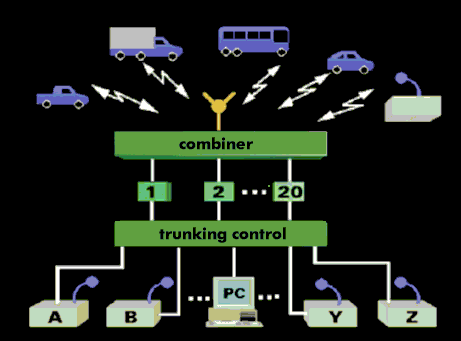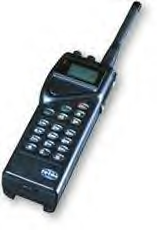trunking radio
Trunked radio is a cellular mobile radio service for operational communications applications, especially for voice communications. Trunked radio, also known as trunked radio, is a further development of private mobile radio in which many users share a channel. In trunked radio, the radio channel is assigned to the users dynamically, which leads to much more efficient frequency utilization than in company radio with rigid frequency channel assignment.
As a voice radio, trunked radio works with a switched communication network in which the radio channel assignment is only made when a user signals a connection request. The exclusive radio channel is available to the user for the duration of the connection. A special organizational channel is used for signaling, controlling and monitoring radio traffic.
Trunked radio for corporate mobile communications
Trunked radio networks are available as analog networks and as digital systems. The two digital trunked radio systems currently available are TETRA (Terrestrial Trunked Radio) and Tetrapol, which are not compatible with each other. They are limited to a specific regional area and generally have neither roaming nor handover nor the ability to interconnect with other trunked networks, with the exception of TETRA's ISI specification. They are pure island networks with half- duplex and also with duplex transmission. With half-duplex transmission, one radio channel is available in both traffic directions in time succession; with duplex transmission, both traffic directions are available simultaneously.
Trunked radio provides the various user groups (carriers, service providers, etc.) with the joint use of a frequency bundle for mobile communications.
In contrast to the classic mobile radio networks, the essential feature of trunked radio networks is the provision of communications services within one or more closed user groups.
The technical basis of the new trunked radio networks is, with a few exceptions, the standard of the British Ministry of Post and Telecommunication - MPT 1327. The trunked radio frequencies provided are in the range of 410 MHz to 430 MHz with channel widths of 12.5 kHz for the transmission of voice and data. The frequency range from 410 MHz to 420 MHz is used as the lower band, and the range from 420 MHz to 430 MHz is used as the upper band for half-duplex operation. Current systems operate with analog voice transmission and digital signaling, whereas the new Tetra system, which is standardized throughout Europe, is fully digitized. The range of a radio cell in trunked radio is about 15 km to 20 km, and up to 100 km if several radio cells are used.
Roaming between trunked radio networks is not provided for and makes little sense. In addition to DeTeMobil's trunked radio service Chekker, there are numerous public trunked radio services of licensed private network operators as well as closed private trunked radio systems in Germany. A distinction is made between four different models for trunked radio licenses.
The four license models for trunked radio
In license type A, a regional trunked radio network, private licensees can be licensed in several economic regions. In each of the 14 defined regions, two providers can compete with Telekom AG. License type B refers to regions that are not defined under model A. The transmission area can be defined in this license type. In this license type, the transmission area can be proposed by the licensee and may not exceed a maximum area of 15,000 square kilometers. The thirdlicense type, C, is limited to restricted areas, such as company properties or ports, and the fourth license type, D, is limited to trunked radio networks with a national scope.
In terms of services, trunked radio offers the individual connection between two subscribers, the group call from one to a group of terminals with the options of talk-along, where all subscribers in a group can talk and are heard by all other subscribers, and the option of listen-only. In addition, short messages( SMS) can be sent in trunked radio via the organization channel. A total of 32 different messages can be transmitted with this 5-bit status record.
Data can be transmitted at a speed of 2.4 kbit/s. Trunked radio systems are mainly used in service companies, goods transport, the construction industry and, above all, in the skilled trades. The network code assigned by the regulatory authority for trunked radio is 0167.


